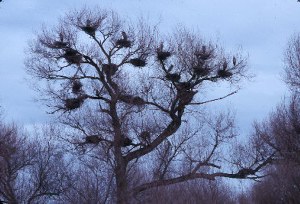
Nesting
Herons form pair-bonds, usually in March and April, after a series of courtship rituals performed by both sexes. The occipital crests are raised in display during courtship and both sexes change body coloration, although the male becomes more brightly adorned.
Although great blue herons occasionally nest singly, most breed in localized colonies of up to hundreds of nesting pairs. Heron colonies are often termed rookeries after a European member of the crow family, the colonial rook, that also nests in colonies. In Chesapeake Bay, nesting sites are primarily living, but occasionally dead, trees and bushes. The location of the colony depends upon an available food supply for raising the young in close proximity to nesting trees; however, the birds show a preference for stands of loblolly pine, beach, oak and large, old sycamore trees. Initially, the inner section of a stand of trees is utilized, but continual colony use may eventually kill that area. When the center of the tree stand dies, the colony moves circularly outward in succeeding years. This strategy creates a "donut" or "bullseye" effect when the tree stand is aerially viewed. Nests are constructed of sticks and, if not collapsed by winter weather, may be repaired and used year after year. The nest is lined with reeds, mosses and grasses to help cushion three to seven eggs that are laid during March and April. Eggs hatch after about 28 days, and both parents care for the chicks. The young are initially fed a diet of regurgitated food, but eventually eat whole fish dropped into the nest. Juveniles leave the nest after about 60 days and, if they survive their first winter, may live for another fifteen years.